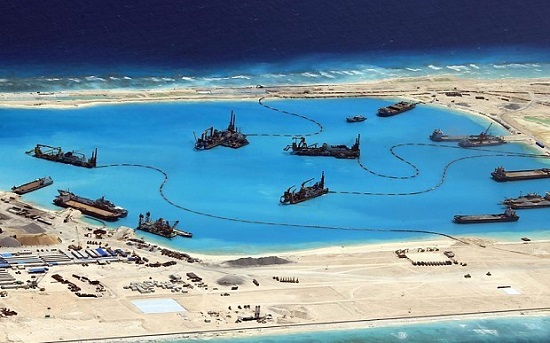China's actions in East Sea destroy coral reefs: US ecologist
Dredging and filling activities during China’s illegal construction and reinforcement of man-made islands in Viet Nam’s Truong Sa (Spratly) archipelago have caused considerable losses of and irreversible damage to the ecosystem here, particularly beautiful and unique coral reefs.
The comment is included in a recent in-depth research entitled “Dredging in the Spratly Islands: Gaining Land but Losing Reefs” by Prof. John McManus from the Department of Marine and Ecology, Rosenstiel School, at the US-based University of Miami.
 |
| China's ships conducting reclamation activities in Vietnam's Fiery Cross Reef (Photo: EPA/VNA) |
The study underlines that the impacts of dredging for the Truong Sa archipelago are of particular concern because the geographical position of these atolls act as stepping stones for reefs to grow and connect over the region and because their high biodiversity works as insurance for many species.
It pointed out that another important attribute of atolls in the East Sea (Bien Dong) internationally known as South China Sea, is the great diversity of species. Over 6,500 marine species are recorded for these atolls, including some 571 reef coral species (more than half of the world’s known species of reef-building corals), it noted.
According to the study, the relatively better health and high diversity of coral reefs in atolls over the East Sea highlights the uniqueness of such reefs and the important roles they may play for reefs throughout the entire region.
Furthermore, these atolls are safe harbour for some of the last viable populations of highly threatened species and several species of sawfishes, highlighting how dredging in the East Sea may threaten not only species with extinction, but also the commitment by countries in the region to biodiversity conservation goals such as the Convention of Biological Diversity Aichi Targets and the United Nations Sustainable Development Goals.
The seven reclaimed atolls have effectively lost an estimated 11.6 square km (26.9 percent) of their reefs for a gain of approximately 10.7 square km of land from February 2014 to May 2015, the study cited, emphasising that the area of land gained was smaller than the area of reef lost because reefs were lost not only through land reclamation but also through the deepening of reef lagoons to allow boat access.
The study called for joint efforts of all parties in the East Sea to urgently protect the coral reefs in the area, suggesting that the development of a legal framework, such as the one applying in the Antarctic, for the management of the Truong Sa archipelago could prevent conflict, promote functional ecosystems, and potentially result in larger gains for all countries involved.
(Source: VNA)